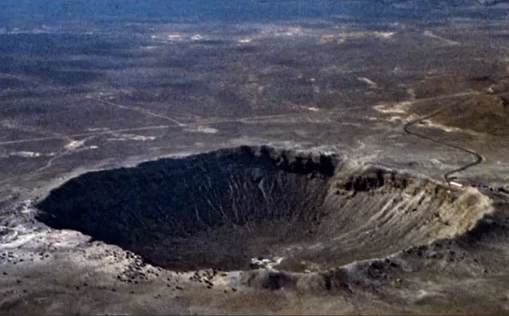Have you ever seen a shooting star, or even a meteor shower?
你见过流星或流星雨吗?
They're some of our favorite things to look for in the night sky.
它们是我们在夜空中最喜欢寻找的东西。
And it's so cool to see the streaks of light!
看到光条纹真是太酷了!
Meteors happen when pieces of dust or rock in space hit the Earth's atmosphere, the air way up in the sky.
流星是太空中的尘埃或岩石撞击地球大气时发生的,
They're going so fast when they hit the atmosphere that they start to get really hot and burn up!
它们在撞击大气层时速度非常快,以至于开始变热燃烧起来!
That's where the light we see comes from.
这就是我们看到的光来源。
Oh, no, don't worry, Squeaks! Meteor showers aren't dangerous.
噢,吱吱,你不用担心。流星雨不危险。
Once the dust or rock burn up, they're gone.
一旦尘埃或岩石燃烧起来,它们就消失了。
Meteor showers can look really beautiful, and they're something special to watch for.
流星雨可能看起来很漂亮,但也有些需要特别注意的地方。
That's a great question.
问得好。
Squeaks wants to know what would happen if a much bigger piece of rock hit the Earth.
吱吱想要知道如果更大的岩石撞击地球会发生什么。
What would that look like?
那会是什么样子?
Well, Squeaks, that actually does happen sometimes.
吱吱,这种情况有时确实会发生。
If a rock is big enough, not all of it will burn up as it falls through the atmosphere.
如果是大块岩石,它在穿过大气层时并不会完全燃烧掉。
Every year, about 30 bigger pieces of rock make it all the way through the Earth's atmosphere.
每年,大约有30块大岩石穿过地球大气层。
But many of them don't even hit the ground,
但它们中有许多撞不到地面,
and if they do, they usually fall in remote places or the ocean, so we don't see them.
如果撞到了,它们通常落在遥远的地方或海洋,所以我们看不到。

Every once in a while, though, people do find pieces of them.
然而,每隔一段时间,人们就会发现它们的碎片。
These pieces are called meteorites, and there are some big, cool-looking ones you can find in museums.
这些碎片叫做陨石,你可以在博物馆找到一些看起来很酷的大陨石。
We also know that some huge rocks, called asteroids, hit the Earth a very long time ago.
我们知道,一些叫做小行星的巨大岩石很久以前就撞击地球了。
Like 65 million years ago, when a very large asteroid hit the Earth.
比如6500万年前,一颗巨大的小行星撞击了地球。
It was about 10 kilometers, or 6 miles wide!
它大约有10公里,或6英里宽!
It would probably take you about 2 hours to walk that far.
你大概要花2个小时才能走那么远。
That's how gigantic it was.
由此可见它是多么巨大。
When that asteroid hit Earth,
当小行星撞击地球时,
the impact was so powerful that scientists think it caused the extinction of many dinosaurs.
影响巨大,以至于科学家认为它是导致许多恐龙灭绝的原因。
The asteroid created a giant crater, a hole in the ground shaped like a bowl.
这颗小行星撞出了一个巨大的陨石坑,即地面上形似碗的洞。
That crater is still there, in Mexico!
这个陨石坑仍然存在,就在墨西哥!
And you know what's covered in craters?
你知道什么物体遍布陨石坑吗?
That's right, the moon!
说对了,月球!
The moon doesn't have an atmosphere with lots of air like Earth does,
月球不像地球,没有大气层,
so the rocks that hit it don't burn up,
所以岩石撞击它时不会燃烧,
they get all the way to the surface and make a crater when they land.
它们一直落到其表面,着陆时撞出陨石坑。
And, since the moon doesn't have things like trees or dirt or flowing water to cover them up,
而且,由于月球没有树木、尘埃或流水覆盖,
it's really easy to see all those craters!
我们很容易就能看到这些陨石坑!
Squeaks was wondering if we should be worried about a big asteroid hitting the Earth again any time soon.
吱吱想知道我们是否需要担心大颗小行星不久后再次撞击地球。
And, it's really not something to be worried about.
这真没什么可担心的。
Astronomers, the scientists who study space, use their telescopes to keep track of all the asteroids nearby.
研究太空的天文学家们利用望远镜追踪地球附近的所有小行星。
We know where they're going in space, and we can tell that none of them will hit the Earth.
我们知道它们在太空的位置,可以辨别它们不会撞击地球。
But even though we won't see a real asteroid impact,
即使我们看不到小行星的真正影响,
do you want to do an experiment to see how rocks falling from space make craters?
但你想做实验来看看太空中的岩石是如何形成陨石坑的吗?
Let's do it! All you'll need are a few things that you probably already have around the house.
我们开始吧!你需要的所有东西可能在你家里都有。
To create your own craters, you'll need: a baking dish or cookie sheet;
为了制造你自己的陨石坑,你需要准备:烤盘或烤板、
flour; cocoa powder, or any other kind of powder as a long as it's a different color than the flour;
面粉、可可粉或任何区别于面粉颜色的粉末、
a sifter; and some small, round objects.
筛子、还有一些圆形的小物件。
We're going to use bouncy balls, but you can use marbles, or even foods like nuts or sunflower seeds.
我们要用的是弹性球,但你也可以用弹珠甚至是坚果或葵花籽之类的食物。
If you don't want to make a mess,
如果你不想弄得一团糟,
you can spread out some newspaper or do this experiment outside.
可以铺几张报纸或去外面做实验。
The first thing we're going to do is add two or three centimeters,
我们首先要做的是加两到三厘米
or about an inch, of flour to the baking dish or cookie sheet.
或一英寸的面粉到烤盘或烤板上。
Try to spread it out evenly.
试着把它们均匀散开。
Then, using the sifter, we'll add a thin layer of the cocoa powder to the top of the flour.
然后用筛子加一层薄薄的可可粉到面粉上。
These layers are like the surface of the Earth!
这些粉末层就像地球的表面!
The cocoa powder is like the top layer of dirt, and the flour is like the rocks underneath.
可可粉像顶层的尘埃,面粉像底下的岩石。
Now: assemble your space rocks!
现在,收集你的太空岩石!
That's what these bouncy balls are for, or whatever you're using as your small, round objects, like nuts or seeds.
这就是弹性球的作用了,或用做圆形小物件的任何东西也可以,比如坚果或种子。
They're going to act like the rocks falling from the sky!
它们充当从太空降落的岩石!
Take one of your space rocks and hold it up about a meter above the flour.
拿一块太空岩石,把它举高到面粉上方大约一米的位置。
Before you drop it, can you predict what might happen when it makes the impact?
在你扔它前,你能预测它会造成什么影响吗?
Squeaks thinks the flour will go everywhere!
吱吱认为面粉到处都是!
Let's see what happens. 3,2,1...
我们拭目以待。3,2,1...
You can see what happens to the surface when the rock hits.
你可以看到岩石撞击时表面会怎么样。
It's almost like a tiny explosion!
它就像一场微型爆炸!
What's left behind is the crater!
留下了陨石坑!
Just like the craters here on Earth, or all those craters on the moon!
就和地球和月球上的陨石坑一样。
You can keep experimenting with different objects from different heights to see what kinds of craters they make.
你可以用不同的物体从不同的高度做实验,看看它们产生的陨石坑类型。
And if you try this experiment, we'd love to know how it goes!
如果你做这个实验的话,我们很想知道你是怎么做的!
Ask a grown-up to help you leave a comment below, or send us an email tokids@scishow.com.
找个大人帮忙在下方留言,或发邮件至kids@scishow.com。
Thanks, we'll see you next time, here the Fort.
感谢您的收看,我们下期见,沃斯堡等你哦!












